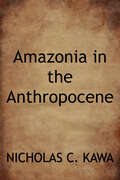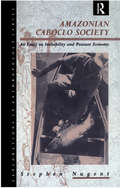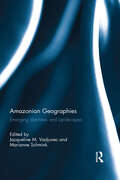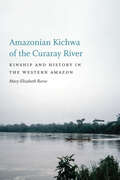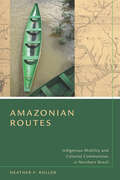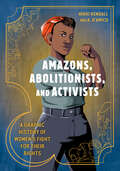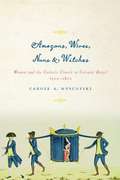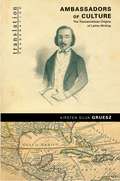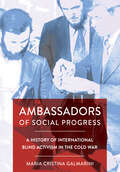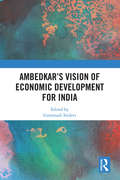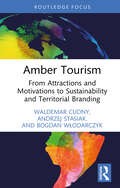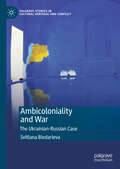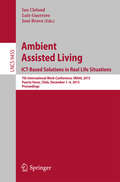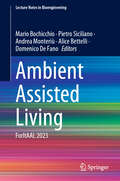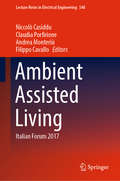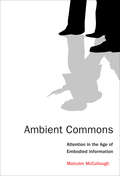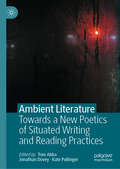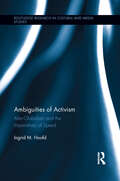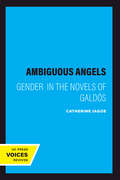- Table View
- List View
Amazonia in the Anthropocene: People, Soils, Plants, Forests
by Nicholas C. KawaWidespread human alteration of the planet has led many scholars to claim that we have entered a new epoch in geological time: the Anthropocene, an age dominated by humanity. <p><p>This ethnography is the first to directly engage the Anthropocene, tackling its problems and paradoxes from the vantage point of the world's largest tropical rainforest. Drawing from extensive ethnographic research, Nicholas Kawa examines how pre-Columbian Amerindians and contemporary rural Amazonians have shaped their environment, describing in vivid detail their use and management of the region's soils, plants, and forests. At the same time, he highlights the ways in which the Amazonian environment resists human manipulation and control--a vital reminder in this time of perceived human dominance. <p><p>Written in engaging, accessible prose, Amazonia in the Anthropocene offers an innovative contribution to debates about humanity's place on the planet, encouraging deeper ecocentric thinking and a more inclusive vision of ecology for the future.
Amazonian Caboclo Society: An Essay on Invisibility and Peasant Economy (Explorations in Anthropology)
by Stephen NugentAmazonian Caboclo Society is concerned with peasant society in Brazilian Amazonia. Most anthropological work in Amazonia has focused on Indian groups, and caboclos (peasants of mixed ancestry) have generally been regarded as relics of the haphazard development of Amazonia and have received little serious attention. This volume aims to analyze the reasons for the relative 'invisibility' of caboclo society. It traces the development of caboclo societies and argues that much of the current discussion of 'sustainable development' fails to recognize the important legacy of historical caboclo society.
Amazonian Cosmopolitans: Navigating a Shamanic Cosmos, Shifting Indigenous Policies, and Other Modern Projects
by Suzanne OakdaleAmazonian Cosmopolitans focuses on the autobiographical accounts of two Brazilian Indigenous leaders, Prepori and Sabino, Kawaiwete men whose lives spanned the twentieth century, when Amazonia increasingly became the context of large-scale state projects. Both give accounts of how they worked in a range of interethnic enterprises from the 1920s to the 1960s in central Brazil. Prepori, a shaman, also gives an account of his relations with spirit beings that populate the Kawaiwete cosmos as he participated in these projects. Like other Indigenous Amazonians, Kawaiwete value engagement with outsiders, particularly for leaders and shamanic healers. These social engagements encourage a careful watching and learning of others&’ habits, customs, and sometimes languages, what could be called a kind of cosmopolitanism or an attitude of openness, leading to an expansion of the boundaries of community. The historical consciousness presented by these narrators centers on how transformations in social relations were experienced in bodily terms—how their bodies changed as new relationships formed. Amazonian Cosmopolitans offers Indigenous perspectives on twentieth-century Brazilian history as well as a way to reimagine lowland peoples as living within vast networks, bridging wide social and cosmological divides.
Amazonian Geographies: Emerging Identities and Landscapes
by Jacqueline M. Vadjunec and Marianne SchminkAmazonia exists in our imagination as well as on the ground. It is a mysterious and powerful construct in our psyches yet shares multiple (trans)national borders and diverse ecological and cultural landscapes. It is often presented as a seemingly homogeneous place: a lush tropical jungle teeming with exotic wildlife and plant diversity, as well as the various indigenous populations that inhabit the region. Yet, since Conquest, Amazonia has been linked to the global market and, after a long and varied history of colonization and development projects, Amazonia is peopled by many distinct cultural groups who remain largely invisible to the outside world despite their increasing integration into global markets and global politics. Millions of rubber tappers, neo-native groups, peasants, river dwellers, and urban residents continue to shape and re-shape the cultural landscape as they adapt their livelihood practices and political strategies in response to changing markets and shifting linkages with political and economic actors at local, regional, national, and international levels.This book explores the diversity of changing identities and cultural landscapes emerging in different corners of this rapidly changing region.This book was published as a special issue of the Journal of Cultural Geography.
Amazonian Kichwa of the Curaray River: Kinship and History in the Western Amazon
by Mary-Elizabeth ReeveAmazonian Kichwa of the Curaray River is an exploration of the dynamics of regional societies and the ways in which kinship relationships define the scale of these societies. It details social relations across Kichwa-speaking indigenous communities and among neighboring members of other ethnolinguistic groups to explore the multiple ways in which the regional society is conceptualized among Amazonian Kichwa. Drawing on recent studies in kinship, landscape from an indigenous perspective, and social scaling, Mary-Elizabeth Reeve presents a view of Amazonian Kichwa as embedded in a multiethnic regional society of great historic depth. This book is a fine-grained ethnography of the Kichwa of the Curaray River region (Curaray Runa) in which Reeve focuses on ideas of social landscape, as well as residence, extended kin groups, historical memory, and collective ritual celebration, to show the many ways in which Curaray Runa express their placement within a regional society. The final chapter examines social scaling as it is currently unfolding in indigenous societies in Amazonian Ecuador through increasing multisited residence and political mobilization. Based on intensive fieldwork, Amazonian Kichwa of the Curaray River breaks new ground in Amazonian studies by focusing on extended kinship networks at a larger scale and by utilizing both ethnographic and archival research of Amazonian regional systems.
Amazonian Routes: Indigenous Mobility and Colonial Communities in Northern Brazil
by Heather F. RollerThis book reconstructs the world of eighteenth-century Amazonia to argue that indigenous mobility did not undermine settlement or community. In doing so, it revises longstanding views of native Amazonians as perpetual wanderers, lacking attachment to place and likely to flee at the slightest provocation. Instead, native Amazonians used traditional as well as new, colonial forms of spatial mobility to build enduring communities under the constraints of Portuguese colonialism. Canoeing and trekking through the interior to collect forest products or to contact independent native groups, Indians expanded their social networks, found economic opportunities, and brought new people and resources back to the colonial villages. When they were not participating in these state-sponsored expeditions, many Indians migrated between colonial settlements, seeking to be incorporated as productive members of their chosen communities. Drawing on largely untapped village-level sources, the book shows that mobile people remained attached to their home communities and committed to the preservation of their lands and assets. This argument still matters today, and not just to scholars, as rural communities in the Brazilian Amazon find themselves threatened by powerful outsiders who argue that their mobility invalidates their claims to territory.
Amazons in America: Matriarchs, Utopians, and Wonder Women in U.S. Popular Culture
by Keira V. WilliamsWith this remarkable study, historian Keira V. Williams shows how fictional matriarchies—produced for specific audiences in successive eras and across multiple media—constitute prescriptive, solution-oriented thought experiments directed at contemporary social issues. In the process, Amazons in America uncovers a rich tradition of matriarchal popular culture in the United States. Beginning with late-nineteenth-century anthropological studies, which theorized a universal prehistoric matriarchy, Williams explores how representations of women-centered societies reveal changing ideas of gender and power over the course of the twentieth century and into the present day. She examines a deep archive of cultural artifacts, both familiar and obscure, including L. Frank Baum’s The Wizard of Oz series, Progressive-era fiction like Charlotte Perkins Gilman’s utopian novel Herland, the original 1940s Wonder Woman comics, midcentury films featuring nuclear families, and feminist science fiction novels from the 1970s that invented prehistoric and futuristic matriarchal societies. While such texts have, at times, served as sites of feminist theory, Williams unpacks their cyclical nature and, in doing so, pinpoints some of the premises that have historically hindered gender equality in the United States. Williams also delves into popular works from the twenty-first century, such as Tyler Perry’s Madea franchise and DC Comics/Warner Bros.’ globally successful film Wonder Woman, which attest to the ongoing presence of matriarchal ideas and their capacity for combating patriarchy and white nationalism with visions of rebellion and liberation. Amazons in America provides an indispensable critique of how anxieties and fantasies about women in power are culturally expressed, ultimately informing a broader discussion about how to nurture a stable, equitable society.
Amazons, Abolitionists, and Activists: A Graphic History of Women's Fight for Their Rights
by Mikki KendallA bold and gripping graphic history of the fight for women&’s rights by the New York Times bestselling author of Hood Feminism &“A beautifully drawn, hold-no-punches, surprisingly deep dive through the history of women's rights around the world, which will entrance kids and adults alike.&”—N. K. Jemisin, Hugo Award–winning author of the Broken Earth trilogy The ongoing struggle for women&’s rights has spanned human history, touched nearly every culture on Earth, and encompassed a wide range of issues, such as the right to vote, work, get an education, own property, exercise bodily autonomy, and beyond. Amazons, Abolitionists, and Activists is a fun and fascinating graphic novel–style primer that covers the key figures and events that have advanced women&’s rights from antiquity to the modern era. In addition, this compelling book illuminates the stories of notable women throughout history—from queens and freedom fighters to warriors and spies—and the progressive movements led by women that have shaped history, including abolition, suffrage, labor, civil rights, LGBTQ liberation, reproductive rights, and more. Examining where we've been, where we are, and where we're going, Amazons, Abolitionists, and Activists is an indispensable resource for people of all genders interested in the fight for a more liberated future.
Amazons, Wives, Nuns, and Witches: Women and the Catholic Church in Colonial Brazil, 1500-1822
by Carole A. MyscofskiThe Roman Catholic church played a dominant role in colonial Brazil, so that women's lives in the colony were shaped and constrained by the Church's ideals for pure women, as well as by parallel concepts in the Iberian honor code for women. Records left by Jesuit missionaries, Roman Catholic church officials, and Portuguese Inquisitors make clear that women's daily lives and their opportunities for marriage, education, and religious practice were sharply circumscribed throughout the colonial period. Yet these same documents also provide evocative glimpses of the religious beliefs and practices that were especially cherished or independently developed by women for their own use, constituting a separate world for wives, mothers, concubines, nuns, and witches. Drawing on extensive original research in primary manuscript and printed sources from Brazilian libraries and archives, as well as secondary Brazilian historical works, Carole Myscofski proposes to write Brazilian women back into history, to understand how they lived their lives within the society created by the Portuguese imperial government and Luso-Catholic ecclesiastical institutions. Myscofski offers detailed explorations of the Catholic colonial views of the ideal woman, the patterns in women's education, the religious views on marriage and sexuality, the history of women's convents and retreat houses, and the development of magical practices among women in that era. One of the few wide-ranging histories of women in colonial Latin America, this book makes a crucial contribution to our knowledge of the early modern Atlantic World.
Ambassadors of Culture: The Transamerican Origins of Latino Writing (Translation/Transnation #44)
by Kirsten Silva GrueszThis polished literary history argues forcefully that Latinos are not newcomers in the United States by documenting a vast network of Spanish-language cultural activity in the nineteenth century. Juxtaposing poems and essays by both powerful and peripheral writers, Kirsten Silva Gruesz proposes a major revision of the nineteenth-century U.S. canon and its historical contexts. Drawing on previously unpublished archival materials and building on an innovative interpretation of poetry's cultural role, Ambassadors of Culture brings together scattered writings from the borderlands of California and the Southwest as well as the cosmopolitan exile centers of New York, New Orleans, and San Francisco. It reads these productions in light of broader patterns of relations between the U.S. and Latin America, moving from the fraternal rhetoric of the Monroe Doctrine through the expansionist crisis of 1848 to the proto-imperialist 1880s. It shows how ''ambassadors of culture'' such as Whitman, Longfellow, and Bryant propagated ideas about Latin America and Latinos through their translations, travel writings, and poems. In addition to these well-known figures and their counterparts in the work of nation-building in Cuba, Mexico, and Central and South America, this book also introduces unremembered women writers and local poets writing in both Spanish and English. In telling the almost forgotten early history of travels and translations between U.S. and Latin American writers, Gruesz shows that Anglo and Latino traditions in the New World were, from the beginning, deeply intertwined and mutually necessary.
Ambassadors of Social Progress: A History of International Blind Activism in the Cold War (NIU Series in Slavic, East European, and Eurasian Studies)
by Maria Cristina GalmariniAmbassadors of Social Progress examines the ways in which blind activists from the Soviet Union and Eastern Europe entered the postwar international disability movement and shaped its content and its course. Maria Cristina Galmarini shows that the international work of socialist blind activists was defined by the larger politics of the Cold War and, in many respects, represented a field of competition with the West in which the East could shine. Yet, her study also reveals that socialist blind politics went beyond propaganda. When socialist activists joined the international blind movement, they initiated an exchange of experiences that profoundly impacted everyone involved. Not only did the international blind movement turn global disability welfare from philanthropy to self-advocacy, but it also gave East European and Soviet activists a new set of ideas and technologies to improve their own national movements. By analyzing the intersection of disability and politics, Ambassadors of Social Progress enables a deeper, bottom-up understanding of cultural relations during the Cold War. Galmarini significantly contributes to the little-studied history of disability in socialist Europe, and ultimately shows that disability activism did not start as an import from the West in the post-1989 period, but rather had a long and meaningful tradition that was rooted in the socialist system of welfare and needed to be reinvented when this system fell apart.
Ambedkar’s Vision of Economic Development for India
by Gummadi SrideviThis book discusses Ambedkar’s engagements with the issues of social justice, economic development and caste enclosures. It highlights his significant contributions in the field of trade, public finance and monetary economics, Indian agriculture, education, among others, and examines their relevance in contemporary India. The volume analyses the basic theoretical conceptions in Ambedkar’s writings which attributed a key role to industrialisation, favoured economic planning and progressive labour laws. It reaffirms these theories and illustrates that focus on social and economic democracy promotes productivity, equitable distribution of wealth and an inclusive society. Through an analysis of Ambedkar’s interdisciplinary works, the book discusses issues of rural poverty, lagging infrastructure growth, the persistence of an exploitative ruling class and the economic and social marginalisation of the downtrodden which are still relevant today. Further, it offers solutions for a restructuring of the society under democratic principles which would recognise the basic right of all to social dignity, and devise means to insure against social and economic insecurity. Insightful and authoritative, this volume will be of great interest to students and researchers of economics, sociology, development studies and social exclusion.
Amber Tourism: From Attractions and Motivations to Sustainability and Territorial Branding (Routledge Insights in Tourism Series)
by Waldemar Cudny Andrzej Stasiak Bogdan WłodarczykThis book explores the multi-faceted nature of amber tourism, illustrating how amber, both a natural and cultural resource, has evolved into a tourist attraction. Combining theoretical insights with diverse case studies, the book examines the key factors shaping its significance in the tourism industry.It provides a deeper understanding of amber-related tourist attractions and motivations, along with a well-defined categorisation of amber tourism. It examines how amber tourism aligns with sustainable tourism principles and contributes to the branding of tourist products and destinations. This analysis is grounded in tourism research theories and enriched with case studies from the Baltic region and beyond.The book will appeal to students and researchers in sustainable tourism, tourism development, tourism management, heritage management, and place branding.
Ambicoloniality and War: The Ukrainian-Russian Case (Palgrave Studies in Cultural Heritage and Conflict)
by Svitlana BiedarievaThis book proposes a new notion of “ambicoloniality” to speak about the current situation when Ukraine has become Russia's territory of obsession, and Russia, in its desire to occupy Ukraine, has in effect subjected itself to Ukraine’s symbolic dominance. Ambicoloniality presents a key point of divergence from already existing models, as the mutual impact of the two countries over centuries has gone both ways, over a shared border — in contrast to other empires that established their colonial power relations at a distance. The Ukrainian-Russian case is very different from the examples covered by both postcolonial and decolonial theorists. To explore the reasons and consequences of such a differing process of colonial expansion/ anti-colonial struggle/ decolonial release, the book inquires into the historical and cultural reasons for the emerging gap between the two states. It explores which role cultural hybridity plays in political self-identification in both Ukraine and Russia, and how this hybridity has manifested in society and culture (including examples of art and literature) following the dissolution of the Soviet Union in 1991, until 2023.
Ambient Assisted Living. ICT-based Solutions in Real Life Situations: 7th International Work-Conference, IWAAL 2015, Puerto Varas, Chile, December 1-4, 2015, Proceedings (Lecture Notes in Computer Science #9455)
by José Bravo Ian Cleland Luis GuerreroThis book constitutes the refereed proceedings of the 7th International Work-Conference on Ambient Assisted Living, IWAAL 2015, held in Puerto Varas, Chile, in December 2015. The 20 full papers presented with 7 short papers were carefully reviewed and selected from 31 submissions. The focus of the papers is on following topics: ambient assisted living for tele-care and tele-rehabilitation; ambient assisted living environments; behaviour analysis and activity recognition; sensing for health and wellbeing; human interaction and perspectives in ambient assisted living solutions.
Ambient Assisted Living: ForItAAL 2023 (Lecture Notes in Bioengineering)
by Pietro Siciliano Andrea Monteriù Alice Bettelli Mario Bochicchio Domenico De FanoThis book provides state-of-the-art information on ambient assisted living (AAL), and focuses on technologies, services, living spaces, policies, and interventions to promote health, improve quality of life, and active aging. It includes various research contributions, case studies, and projects where assistive technologies are successfully applied in the field, and it covers a wide range of topics: Tailoring products and services to the Aging society, Bio-data and Artificial sensing AAL scenarios, Cognition, and Technologies, and Designing for Inclusion and Well-Being. The volume gathers the refereed proceedings of the 12th Italian Forum on Ambient Assisted Living (ForItAAL), held in Bari, Italy on June 14-16, 2023. With its wide-ranging contributions to the topic, the book will inspire the readers and the researchers to continue their exploration of AAL technologies to support the development of products and services that make a real difference in people’s daily lives.
Ambient Assisted Living: Italian Forum 2017 (Lecture Notes in Electrical Engineering #540)
by Andrea Monteriù Filippo Cavallo Niccolò Casiddu Claudia PorfirioneThis book documents the state of the art in the field of ambient assisted living (AAL), highlighting the impressive potential of novel methodologies and technologies to enhance well-being and promote active ageing. It covers a broad range of topics, with sections on technological sensors and platforms, social robotics for assistance, assistance and care applications, health and medical support methodologies and technologies, as well as the analysis, modelling and design of AAL services. <P><P> The book comprises a selection of the best papers presented at the 8th Italian Forum on Ambient Assisted Living (ForitAAL 2017), which was held in Genoa, Italy, in June 2017 and brought together researchers, technology teams and professional associations, as well as representatives of the Italian regions and advisors to the Italian Ministry of Education, University and Research, with the goal of developing a consensus on how to improve provisions for the elderly and impaired. The respective contributions offer valuable insights into how the latest advances can help address the needs of the elderly and those with chronic health conditions. They also underscore the need for AAL to continue moving toward multidisciplinary integration, so as to embrace the various disciplines that place the user of services at the centre of the design process.
Ambient Commons: Attention in the Age of Embodied Information (The\mit Press Ser.)
by Malcolm McCulloughOn rediscovering surroundings when information goes everywhere.The world is filling with ever more kinds of media, in ever more contexts and formats. Glowing rectangles have become part of the scene; screens, large and small, appear everywhere. Physical locations are increasingly tagged and digitally augmented. Amid this flood, your attention practices matter more than ever. You might not be able to tune this world out. So it is worth remembering that underneath all these augmentations and data flows, fixed forms persist, and that to notice them can improve other sensibilities. In Ambient Commons, Malcolm McCullough explores the workings of attention through a rediscovery of surroundings.McCullough describes what he calls the Ambient: an increasing tendency to perceive information superabundance whole, where individual signals matter less and at least some mediation assumes inhabitable form. He explores how the fixed forms of architecture and the city play a cognitive role in the flow of ambient information. As a persistently inhabited world, can the Ambient be understood as a shared cultural resource, to be socially curated, voluntarily limited, and self-governed as if a commons? Ambient Commons invites you to look past current obsessions with smart phones to rethink attention itself, to care for more situated, often inescapable forms of information.
Ambient Literature: Towards a New Poetics of Situated Writing and Reading Practices
by Kate Pullinger Tom Abba Jonathan DoveyThis book considers how a combination of place-based writing and location responsive technologies produce new kinds of literary experiences. Building on the work done in the Ambient Literature Project (2016–2018), this books argues that these encounters constitute new literary forms, in which the authored text lies at the heart of an embodied and mediated experience. The visual, sonic, social and historic resources of place become the elements of a live and emergent mise-en-scène. Specific techniques of narration, including hallucination, memory, history, place based writing, and drama, as well as reworking of traditional storytelling forms combine with the work of app and user experience design, interaction, software authoring, and GIS (geographical information systems) to produce ambient experiences where the user reads a textual and sonic literary space. These experiences are temporary, ambiguous, and unpredictable in their meaning but unlike the theatre, the gallery, or the cinema they take place in the everyday shared world. The book explores the potentiality of a new literary form produced by the exchange between location-aware cultural objects, writers and readers. This book, and the work it explores, lays the ground for a new poetics of situated writing and reading practices.
Ambient Media: Japanese Atmospheres of Self
by Paul RoquetAmbient Media examines music, video art, film, and literature as tools of atmospheric design in contemporary Japan, and what it means to use media as a resource for personal mood regulation. Paul Roquet traces the emergence of ambient styles from the environmental music and Erik Satie boom of the 1960s and 1970s to the more recent therapeutic emphasis on healing and relaxation.Focusing on how an atmosphere works to reshape those dwelling within it, Roquet shows how ambient aesthetics can provide affordances for reflective drift, rhythmic attunement, embodied security, and urban coexistence. Musicians, video artists, filmmakers, and novelists in Japan have expanded on Brian Eno&’s notion of the ambient as a style generating &“calm, and a space to think,&” exploring what it means to cultivate an ambivalent tranquility set against the uncertain horizons of an ever-shifting social landscape. Offering a new way of understanding the emphasis on &“reading the air&” in Japanese culture, Ambient Media documents both the adaptive and the alarming sides of the increasing deployment of mediated moods.Arguing against critiques of mood regulation that see it primarily as a form of social pacification, Roquet makes a case for understanding ambient media as a neoliberal response to older modes of collective attunement—one that enables the indirect shaping of social behavior while also allowing individuals to feel like they are the ones ultimately in control.
Ambient Play (Playful Thinking)
by Larissa Hjorth Ingrid RichardsonAn engaging look at how mobile games are increasingly part of our day-to-day lives and the ways that we interact across real as well as digital landscapes.We often play games on our mobile devices when we have some time to kill--waiting in line, pausing between tasks, stuck on a bus. We play in solitude or in company, alone in a bedroom or with others in the family room. In Ambient Play, Larissa Hjorth and Ingrid Richardson examine how mobile gameplay fits into our day-to-day lives. They show that as mobile games spread across different genres, platforms, practices, and contexts, they become an important way of experiencing and navigating a digitally saturated world. We are digital wayfarers, moving constantly among digital, social, and social worlds.
Ambient Television: Visual Culture and Public Space
by Anna MccarthyAlthough we tend to think of television primarily as a household fixture, TV monitors outside the home are widespread: in bars, laundromats, and stores; conveying flight arrival and departure times in airports; uniting crowds at sports events and allaying boredom in waiting rooms; and helping to pass the time in workplaces of all kinds. In Ambient Television Anna McCarthy explores the significance of this pervasive phenomenon, tracing the forms of conflict, commerce, and community that television generates outside the home. Discussing the roles television has played in different institutions from 1945 to the present day, McCarthy draws on a wide array of sources. These include retail merchandising literature, TV industry trade journals, and journalistic discussions of public viewing, as well as the work of cultural geographers, architectural theorists, media scholars, and anthropologists. She also uses photography as a research tool, documenting the uses and meanings of television sets in the built environment, and focuses on such locations as the tavern and the department store to show how television is used to support very different ideas about gender, class, and consumption. Turning to contemporary examples, McCarthy discusses practices such as Turner Private Networks' efforts to transform waiting room populations into advertising audiences and the use of point-of-sale video that influences brand visibility and consumer behavior. Finally, she inquires into the activist potential of out-of-home television through a discussion of the video practices of two contemporary artists in everyday public settings. Scholars and students of cultural, visual, urban, American, film, and television studies will be interested in this thought-provoking, interdisciplinary book.
Ambiguities of Activism: Alter-Globalism and the Imperatives of Speed (Routledge Research in Cultural and Media Studies #43)
by Ingrid M. HoofdThis volume provides a critical and in-depth investigation of the relationship between alter-globalist thinking and practices and their popular discourses. It examines the ways in which several alter-globalist activist groups (like Indymedia, no-borders campaigns, and forms of climate change activism), as well as left-wing intellectuals and academics (like Michael Hardt, Al Gore, Antonio Negri, Hakim Bey, and Geert Lovink), mobilize problematic discourses, tools, and divisions in an attempt to overcome gendered, raced, and classed oppressions worldwide. The book draws out how these mobilizations and theorizations, despite (or possibly because of) their liberatory claims, are actually implicated in the intensification of global hierarchies by repeatedly invoking narratives of transcendence, connection, progress, and in particular of speed. Hoofd argues that the humanist ideals that underlie all these practices paradoxically trigger increasing disenfranchisements worldwide.
Ambiguities of Domination: Politics, Rhetoric, and Symbols in Contemporary Syria
by Lisa WedeenIn Syria, the image of President Hafiz al-Asad is everywhere. In newspapers, on television, and during orchestrated spectacles Asad is praised as the "father," the "gallant knight," even the country's "premier pharmacist. " Yet most Syrians, including those who create the official rhetoric, do not believe its claims. Why would a regime spend scarce resources on a cult whose content is patently spurious? Wedeen concludes that Asad's cult acts as a disciplinary device, generating a politics of public dissimulation in which citizens act as if they revered their leader. By inundating daily life with tired symbolism, the regime exercises a subtle, yet effective form of power. The cult works to enforce obedience, induce complicity, isolate Syrians from one another, and set guidelines for public speech and behavior. Wedeen's ethnographic research demonstrates how Syrians recognize the disciplinary aspects of the cult and seek to undermine them. Provocative and original, Ambiguities of Domination is a significant contribution to comparative politics, political theory, and cultural studies.
Ambiguous Angels: Gender in the Novels of Galdós
by Catherine JagoeThe contradictory nature of the work of Benito Pérez Galdós, Spain's greatest modern novelist, is brought to the fore in Catherine Jagoe's innovative and rigorous study. Revising commonly held views of his feminism, she explores the relation of Galdós's novels to the "woman question" in Spain, arguing that after 1892 the muted feminist discourse of his early work largely disappears. While his later novels have been interpreted as celebrations of the emancipated new woman, Jagoe contends that they actually reinforce the conservative, bourgeois model of frugal, virtuous womanhood—the angel of the house.Using primary sources such as periodicals, medical texts, and conduct literature, Jagoe's examination of the evolution of feminism makes Ambiguous Angels valuable to anyone interested in gender, culture, and narrative in nineteenth-century Europe.
